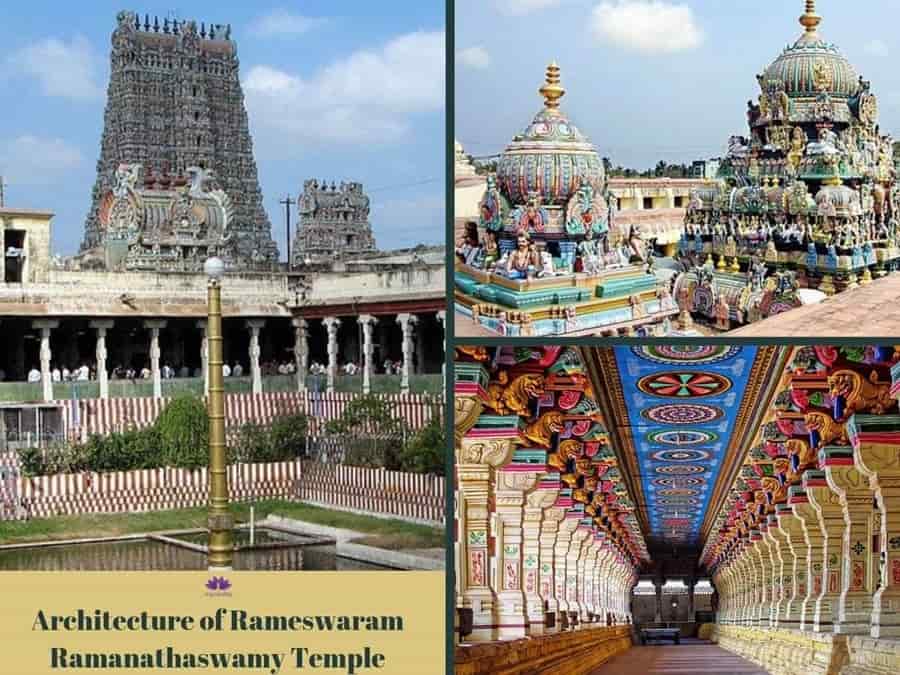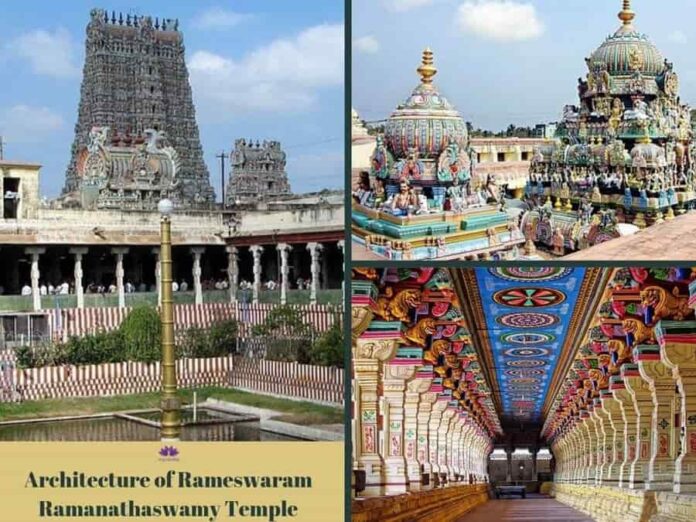The Rameswaram Temple, also known as the Sri Ramanathaswamy Temple, is a magnificent Hindu temple located on the island of Rameswaram in the southern part of India. It is not only one of the holiest pilgrimage sites for Hindus but also a remarkable example of Dravidian temple architecture. The temple is dedicated to Lord Shiva and holds immense significance in the epic Ramayana, as it is believed to be the place where Lord Rama built a bridge (Rama Setu) to reach Sri Lanka and rescue his beloved wife, Sita. In this article, we will delve into the architectural splendors of the Rameswaram Temple, exploring its history, key features, and the cultural and religious significance it holds.

Historical Background
The Rameswaram Temple has a rich history that dates back over a thousand years. It is mentioned in various ancient Hindu scriptures and epics, including the Ramayana, where it is believed to have been consecrated by Lord Rama himself. According to legend, after defeating the demon king Ravana and rescuing Sita, Lord Rama wanted to absolve himself of the sin of killing a Brahmin (Ravana). He was advised by the sage Agastya to pray to Lord Shiva at Rameswaram. Rama built a lingam (a symbol of Lord Shiva) from the sand and performed a puja (ritual offering) to seek forgiveness. This lingam is believed to be the one enshrined in the Rameswaram Temple today.
The historical timeline of the temple is not entirely clear, but it is widely accepted that the original temple structure was built in the 12th century by the Pandya dynasty, with contributions from various rulers and dynasties over the centuries. The temple underwent several renovations and expansions, and the current structure we see today is the result of extensive work carried out in the 17th century.
Key Architectural Features
Gopurams (Entrance Towers)
The Rameswaram Temple is famous for its grand and intricately carved gopurams, which are towering entrance gateways that lead into the temple complex. These gopurams are quintessential elements of Dravidian temple architecture. The temple boasts a total of 22 gopurams, each adorned with beautifully sculpted figures and depictions of various Hindu deities and mythological stories. The most renowned gopuram is the Rajagopuram, which stands at an impressive height of 53 meters (170 feet) and is a prominent landmark in the region.
Corridors (Prakaras)
The temple’s layout is characterized by a series of concentric corridors that encircle the sanctum sanctorum. These corridors provide pilgrims with access to various parts of the temple and also house several smaller shrines, idols, and intricately carved pillars. The corridors are a unique feature of Dravidian architecture and offer a sense of divine connection as devotees circumambulate the innermost sanctum.
Magnificent Pillars
The temple is renowned for its numerous beautifully sculpted pillars. These pillars are adorned with intricate carvings that depict stories from Hindu mythology, as well as intricate floral and geometric patterns. Some of the pillars are monolithic, meaning they are carved from a single piece of stone, showcasing the skill and craftsmanship of the artisans of that era.
Sacred Tanks
The temple complex houses a series of sacred tanks, the most prominent being the Agni Theertham, located right outside the temple. It is believed that taking a dip in these tanks purifies one’s soul. These tanks are an integral part of the temple’s architecture and provide a serene and spiritual atmosphere for pilgrims.
The Lingam
At the heart of the temple lies the main sanctum sanctorum, where the presiding deity, Lord Shiva, is worshipped in the form of a lingam. The lingam is made of sand and is believed to be the one consecrated by Lord Rama himself. The sanctum is a place of great reverence and spirituality, drawing devotees from all over the world.
Intricate Sculptures
The temple is adorned with countless sculptures that depict various deities, mythological episodes, and divine motifs. These sculptures are made of granite and have been meticulously crafted, reflecting the artistic prowess of the sculptors of the time. These intricate sculptures not only beautify the temple but also serve as a source of spiritual inspiration.
Cultural and Religious Significance
The Rameswaram Temple holds immense cultural and religious significance in Hinduism, not only for its architectural beauty but also for its association with the epic Ramayana and the legend of Lord Rama. Here are some key points highlighting the importance of the temple:
Pilgrimage Destination
Rameswaram is one of the Char Dham (four sacred pilgrimage sites) in Hinduism, making it a must-visit destination for devout Hindus. Pilgrims from all over India and beyond travel to Rameswaram to seek the blessings of Lord Shiva and to take a dip in the sacred waters of the Agni Theertham.
The Ramayana Connection
The temple’s close association with the Ramayana makes it even more special. It is believed to be the place where Lord Rama prayed to Lord Shiva for forgiveness and built the bridge to Lanka. The story of Rama’s devotion and the subsequent divine intervention is a central theme in the temple’s religious narrative.
Spiritual Relevance
The temple is not just a place of worship; it is a site where devotees find solace, inner peace, and a deep sense of spirituality. The act of circumambulating the sanctum sanctorum and taking a dip in the sacred tanks is believed to cleanse one’s sins and purify the soul.
Architectural Heritage
The Rameswaram Temple is a symbol of India’s rich architectural heritage, particularly the Dravidian style of temple architecture. It serves as a testament to the artistic skills and cultural achievements of the people of ancient India.
- Suggested Tour: Rameshwaram Tour Packages
Conclusion
The Rameswaram Temple, with its awe-inspiring Dravidian architecture, rich history, and deep religious significance, stands as a cultural and spiritual beacon in India. It is a testament to the architectural prowess of its builders and a place of profound religious devotion for millions of people. The temple’s association with the epic Ramayana and its role in the legend of Lord Rama adds another layer of significance to this sacred site. Pilgrims and tourists alike continue to be captivated by the beauty and sanctity of the Rameswaram Temple, making it a timeless jewel of India’s cultural and spiritual heritage.
Also Read:
















